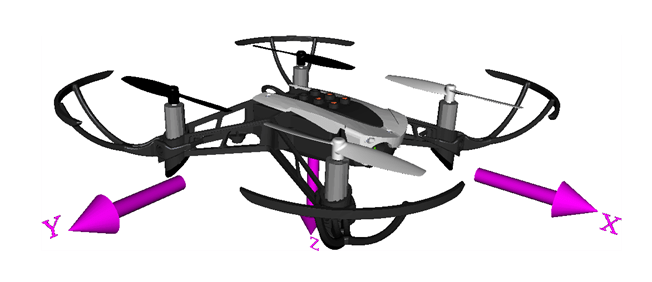Quadcopter Physical Characteristics
This schematic shows these quadcopter physical characteristics:
Axes
Mass and Inertia
Rotors

Axes
The quadcopter body axis is centered in the center of gravity.
X-Axis — The X-axis is represents the longitudinal axis of the drone, extending from the front to the rear of the drone. Movement along the X-axis involves pitching the drone forward or backward.
Y-Axis — The Y-axis represents the transverse axis of the drone, extending from one side of the drone to the other. Movement along the Y-axis involves rolling the drone to the left or right.
Z-Axis — The Z-axis represents the vertical axis of the drone, extending from the top to the bottom of the drone, following the right-hand rule. Movement along the Z-axis involves ascending or descending, as well as yawing the drone to change its heading.
These axes are crucial for understanding and controlling the movement and orientation of the drone in three-dimensional space. They are fundamental for drone control, navigation, and stabilization.
Mass and Inertia
Assume that the whole body works as a rigid body of uniform density. The file
vehicleVars contains the values for the inertia and mass.
Rotors
The Parrot® quadcopter minidrone body typically consists of four rotors, often referred to as propellers. These rotors are responsible for generating the lift required for the drone to achieve flight. In most quadcopters, including the Parrot minidrone, the rotors are configured in a cross pattern, with two rotors spinning clockwise and the other two spinning counterclockwise.
This configuration provides stability and control, as the opposing rotation cancels out the rotational torque, ensuring the drone remains level during flight. Additionally, you can independently control the speed of each rotor to enable the drone to change altitude, pitch, roll, and yaw.
The rotor system is a critical component of the design of the drone. The rotor system is key to maneuverability, stability, and overall flight performance.
Rotor 1 rotates positively with respect to the z-axis. This rotor is located parallel to the xy-plane, -45 degrees from the x-axis.
Rotor 2 rotates negatively with respect to the z-axis of the body. This rotor is located parallel to the xy-plane, 45 degrees from the x-axis.
Rotor 3 has the same rotation direction as rotor 1. This rotor is located parallel to the xy-plane, 135 degrees from the x-axis.
Rotor 4 has the same rotation direction as rotor 2. This rotor is located parallel to the xy-plane, -135 degrees from the x-axis.
This example uses the Multirotor block in the Aerospace Blockset™. The block is based on the approach defined by Prouty and adapted to a heavy-lift quadcopter by Pounds , Mahony, and Corke [1].
Command Subsystem
Use one of these options to provide inputs to the quadcopter for pitch (X), roll (Y), and yaw (Z), as north-east-down (NED) coordinates:
A Signal Editor block
A joystick
Previously saved data
A spreadsheet
Use the VSS_COMMAND variable in the workspace to make the
appropriate choice. This subsystem generates reference command signal to the control
system.
References
[1] Pounds, P., R. Mahony, and P. Corke. "Modelling and Control of a Large Quadrotor Robot." Control Engineering Practice 18, no. 7 (2010): 691–99. https://doi.org/10.1016/j.conengprac.2010.02.008.